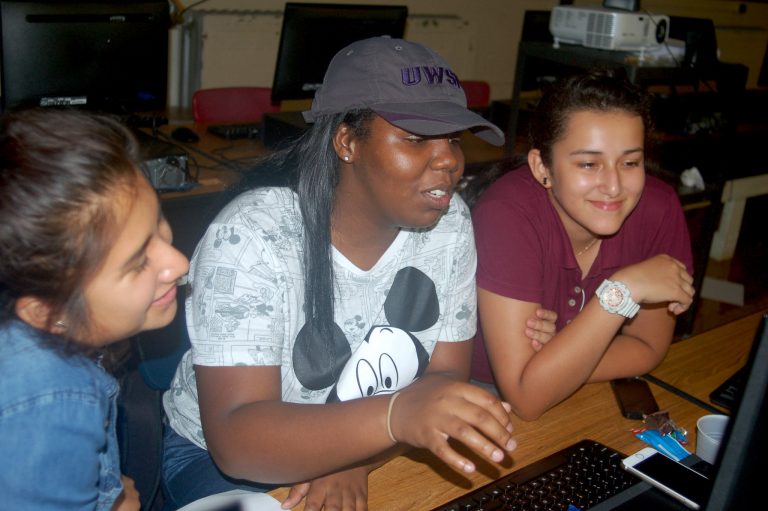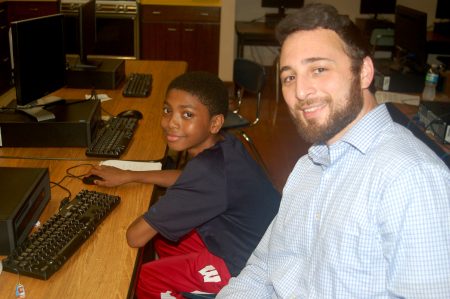Coders of the Future
Pilot computer coding class helps prepare students for tomorrow’s careers

Tamarack Waldorf School students Ana Jacinto, Katera Boss and Karina Arevalo work together on their final project, a game to solve the mystery of the missing homework. Photo by Edgar Mendez.
Sitting in front of a desktop computer in a classroom on the third floor of Carmen High School of Science and Technology’s South Campus, Katera Boss and her classmates, Karina Arevalo and Ana Jacinto, are typing in a language that is hard for the untrained eye to decipher. The students are writing code, the basic programming language that enables computers to perform pre-set commands. The girls are building a game that solves an age-old mystery. Where has the missing homework gone?
“I’m learning a whole lot about computers while creating this game. Learning to code is something I always wanted to do but never had the chance,” Boss said.
For two weeks, Boss, a junior at Tamarack Waldorf School, and eight other teens participated in Layton Boulevard West’s Code Academy, a pilot computer programming class that is teaching them skills they can parlay into careers in an increasingly technology-driven society.
Computer programming is the process of developing a script of instructions, or codes, that enable computers to perform certain functions. The actions could range from commanding the computer to automatically execute a command such as sending a daily email to creating a video game character that performs an animation, said Ben Juarez, who came up with the idea for the class.
Juarez, a Public Policy Forum researcher and Layton Boulevard West resident, created it as part of his participation in the Neighborhood Leadership Institute development program at Cardinal Stritch University. The program pairs two individuals living or working in a Greater Milwaukee Foundation Healthy Neighborhood, in this case Layton Boulevard West, to work together on a plan to benefit their neighborhood.
Juarez teamed up with Araceli Arevalo, community organizer for Clarke Square and Layton Boulevard West at Safe and Sound. Together, they secured a mini-grant from Safe and Sound to fund the class and recruited youth to participate, including Arevalo’s daughter Karina.
“The goal is to help kids understand what is waiting for them in the future,” said Juarez, who taught himself how to program three years ago. What awaits them is a world where even white-collar jobs are becoming automated, added Juarez.
The students, all ages 12-17, spent the first week of the coding class learning the building blocks of Java, a programming language and computing platform. The last two weeks were spent on a project that will be unveiled during a graduation ceremony this weekend. So far, the road has been bumpy since coding is not an easy skill to master, some students admitted. But, it has been rewarding, Jacinto and others said.
“Coding is hard. But, I find it exciting to learn because it’s a skill that’s utilized in all types of professions including in business settings,” Jacinto said.
Coding helps students understand how computers work, and in the process build language, math and logic skills, said Edwin Lagunes, a senior at Rufus King High School who volunteered to help the novice coders.
“One letter off and the program doesn’t work,” warned Lagunes, who has been accepted to the Milwaukee School of Engineering, where he hopes to major in computer programming. He helps the students find their errors and guides them to solve problems on their own.
“That excitement is what keeps me going. They’re getting it!” Omegbu said.
Inevitably, some projects won’t turn out as expected. But, that’s all part of the plan, Juarez said. “I want them to feel good about themselves knowing that they can fail. The scientific method is all about learning from failure,” he added.
There’s been a learning curve for everyone involved, Arevalo said. The students’ emotions have transitioned from confused to excited. “From one week to the next they’ve become more and more engaged,” she added.
Arevalo and Juarez hope to offer the class again. For Arevalo, it’s another way to keep kids safe and off the streets. Juarez added that it brings a new skill to the neighborhood. In turn, the teens could play a part in shaping the future.
“Imagine… we could start of a pipeline of engineers in this community,” Juarez said.
This story was originally published by Milwaukee Neighborhood News Service, where you can find other stories reporting on fifteen city neighborhoods in Milwaukee.





















